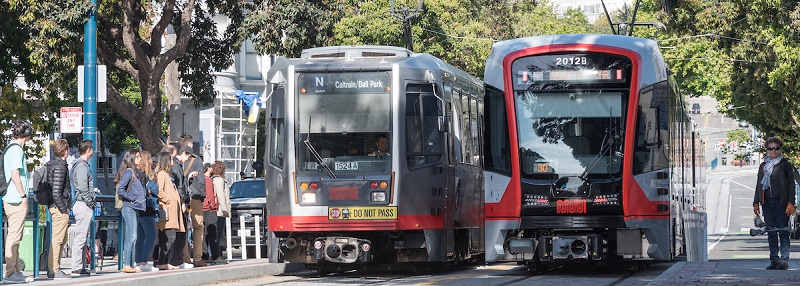
The SFMTA’s 90-Day Plan to Improve Muni is a focused and collaborative effort to implement the SFMTA Strategic Plan through “bite-sized” pieces within a 90-day period.
Centered around the SFMTA Strategic Plan, the development of the SFMTA’s Plan to Improve Muni resulted in the creation of initiatives that differed in duration and scope. The hallmark of the Plan is the near-term initiative, which are a series of “bite-sized” actions and measurable targets that would be implemented in 90-day periods. By breaking down larger goals and initiatives into smaller near-term actions, the agency is better able to deliver effective, focused, and immediate solutions to issues, while still progressing long term plans to improve transit service.
We’re at the end of our current 90-Day period and are very encouraged by the results we’re seeing. Our initiatives for this cycle focused on safety, service reliability, subway performance, LRV 4, and Chase Center service.
Emphasis on Safety
We pursued 8 actions aimed at reducing collisions while also improving safety for operators and passengers. For instance, we were able to install more visible bumpers over 800 buses—as well as add more visible poles to our 60 trolley coaches.
Service Reliability
Service reliability continues to be a challenge for a number of reasons, but we’ve taken significant steps to minimize the impacts throughout our system. We were able to grow our operator classes—meaning more operators are on vehicles and on the streets serving our customers. Small changes that we made to the 27-Bryant route involving stop removal and re-routes has drastically improved north-south connections for our 6,700 weekday riders along that route. Our team’s dedicated work on this line was even nationally recognized for our outreach efforts connecting to passengers, residents, and merchants of different cultural backgrounds, ages, and abilities. Additionally, we continue to receive and accept 40’ trolley coaches into our fleet. We’re averaging about 2 new trolley coaches a week. Another milestone we reached this 90-day cycle was accepting enough new trolley coaches to retire all of our older ETI’s, which became less reliable and past their useful life. We’re excited to announce that we met our short-term goal of 96% service delivery, and we took important steps to reduce missed trips.
LRV 4
Standing at one of our Muni Metro platforms, you’ll see more and more LRV 4s in service picking up and dropping off passengers in both directions. We’ve met the target goal of 35 LRV 4s in service—which helped boost the overall car count to 150 vehicles in service for the rail network. Today, we have more LRVs in service than we’ve ever had before. Along with correcting previous issues with our doors and couplers, we’ve also safety certified a design for additional track brakes. This new design will help keep more LRV 4s on the streets of San Francisco delivering service, instead of in a maintenance shop. Looking ahead, we plan to increase the Siemens to Breda vehicle ratio. Today, we have 67 expansion vehicles delivered with 61 ready for service. These vehicles are the real deal and we’re encouraged by the data supporting improved performance between June and September of this year.
Improving Subway Performance
During peak commute hours, our riders aren’t shy about pointing out subway delays. Our subway performing well is critical to the livelihood of thousands of daily Muni riders. Back in August, we closed the subway early for a period of two weeks to give our maintenance staff time to complete critical maintenance tasks that cannot be completed during normal business hours. The extended window gave us the opportunity to work on overhead lines, tracks, signals, and the Automated Train Control System. We were very encouraged by the amount of work we were able to perform with very little impact on the overall ridership. In fact, we’re striving to perform this critical maintenance work periodically during slower riding seasons to keep our subway in a state of good repair.
Delivering Chase Center Service
For years, our staff has been preparing and coordinating to make sure our system would be able to accommodate an influx of riders using the system to get to Chase Center. In the past three weeks alone, we provided service to 13 Chase Center events which called for additional rail and bus service, supervision, and traffic control. It’s safe to say that our agency really worked together as one—connected to serve a purpose and deliver great, sustainable, and reliable service. From Parking Control Officers to LRV Operators to Communications Ambassadors, our agency came together operationalizing and implementing what was no doubt a monumental task. Going forward, we will continue to fine-tune and equitably balance service across the network. We’ve learned a lot so far—next up: the first Warriors pre-season game on October 5th!
Our next 90-Day Action Plan is scheduled to start on November 1, 2019. To watch our presentation on the current cycle to our Board of Directors, go to sfgovtv.org.